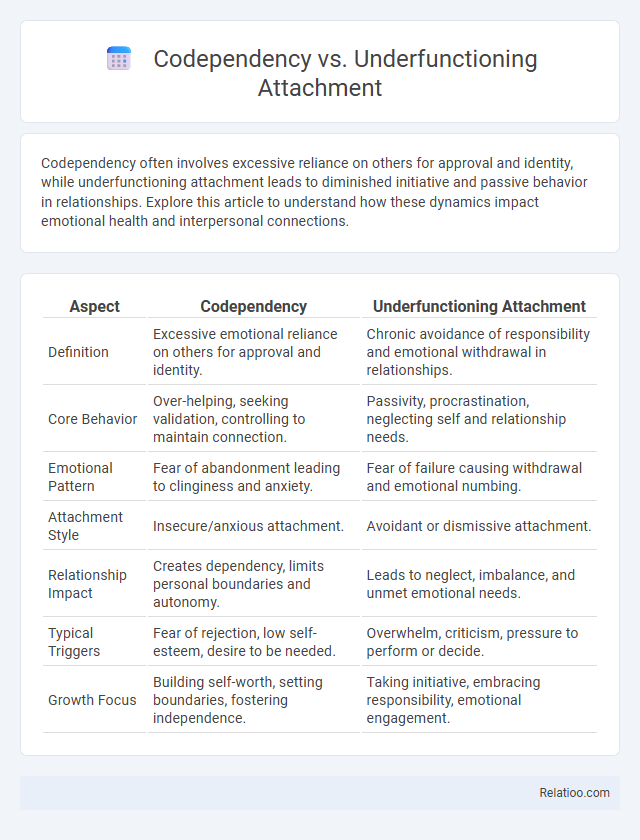Codependency often involves excessive reliance on others for approval and identity, while underfunctioning attachment leads to diminished initiative and passive behavior in relationships. Explore this article to understand how these dynamics impact emotional health and interpersonal connections.
Table of Comparison
| Aspect | Codependency | Underfunctioning Attachment |
|---|---|---|
| Definition | Excessive emotional reliance on others for approval and identity. | Chronic avoidance of responsibility and emotional withdrawal in relationships. |
| Core Behavior | Over-helping, seeking validation, controlling to maintain connection. | Passivity, procrastination, neglecting self and relationship needs. |
| Emotional Pattern | Fear of abandonment leading to clinginess and anxiety. | Fear of failure causing withdrawal and emotional numbing. |
| Attachment Style | Insecure/anxious attachment. | Avoidant or dismissive attachment. |
| Relationship Impact | Creates dependency, limits personal boundaries and autonomy. | Leads to neglect, imbalance, and unmet emotional needs. |
| Typical Triggers | Fear of rejection, low self-esteem, desire to be needed. | Overwhelm, criticism, pressure to perform or decide. |
| Growth Focus | Building self-worth, setting boundaries, fostering independence. | Taking initiative, embracing responsibility, emotional engagement. |
Understanding Codependency: Core Characteristics
Codependency is characterized by excessive emotional reliance on others, often leading to disrupted personal boundaries and a diminished sense of self. Underfunctioning in attachment manifests as difficulty taking initiative or responsibility in relationships, resulting in passive or avoidant behaviors. Understanding these core characteristics helps you recognize patterns that hinder healthy emotional balance and empowers you to foster autonomy and secure connections.
Defining Underfunctioning Attachment Patterns
Underfunctioning attachment patterns manifest as an individual's reliance on others to meet emotional or practical needs, often resulting in a diminished sense of personal agency and self-efficacy. This dynamic contrasts with codependency, which involves an excessive emotional or psychological reliance on a partner, and general underfunctioning, characterized by reduced motivation or productivity without necessarily involving attachment-related behaviors. Understanding underfunctioning attachment requires identifying patterns of avoidance, fear of abandonment, and dependency that disrupt healthy autonomy in relationships.
Key Differences Between Codependency and Underfunctioning
Codependency involves excessive emotional reliance on others, often leading to overfunctioning behaviors such as caretaking and controlling, while underfunctioning is characterized by passivity, lack of initiative, and avoidance of responsibility. In attachment theory, codependency aligns with anxious-preoccupied attachment styles marked by fear of abandonment, whereas underfunctioning may reflect avoidant or disorganized attachment patterns where individuals withdraw or disengage. Key differences include codependency's active involvement in others' lives versus underfunctioning's withdrawal and reduced personal agency in relationships.
Psychological Roots of Codependent Behaviors
Codependent behaviors often stem from deep-seated psychological roots such as insecure attachment styles, where an individual's need for approval and fear of abandonment drive underfunctioning tendencies. Underfunctioning in both codependency and attachment issues manifests as a reliance on others to meet emotional and practical needs, hindering personal growth and autonomy. Understanding these dynamics helps you recognize the patterns that maintain codependent relationships and supports healthier psychological development.
Causes and Development of Underfunctioning Attachment
Underfunctioning attachment develops primarily from inconsistent caregiving, emotional neglect, and early childhood trauma, leading to difficulty in self-regulation and emotional dependency. You may experience underfunctioning attachment when caregivers failed to provide reliable support, resulting in insecurity and a tendency to rely excessively on others for validation and decision-making. These causes often intertwine with codependency and underfunctioning patterns, where emotional needs are suppressed or unmet, perpetuating dysfunctional relational dynamics.
Impact on Relationships: Comparing Behavior Patterns
Codependency involves excessive emotional reliance on others, leading to impaired autonomy and unhealthy attachment, whereas underfunctioning attachment manifests as avoidance or withdrawal, causing emotional distance. Underfunctioning, characterized by passivity and lack of initiative, often results in frustration within relationships due to unmet responsibilities. Understanding these behavior patterns can help you identify dynamics that undermine healthy connections and foster more balanced interactions.
Warning Signs: How to Identify Each Dynamic
Warning signs of codependency include excessive people-pleasing, difficulty setting boundaries, and a chronic need to control others to feel valued. Underfunctioning manifests as persistent procrastination, reliance on others to complete tasks, and avoidance of responsibilities, often stemming from low self-esteem or fear of failure. Attachment-related underfunctioning is characterized by emotional withdrawal, fear of intimacy, and inconsistent engagement in relationships; recognizing these patterns helps you address the root causes of dysfunctional behavior effectively.
Emotional Consequences for Individuals and Partners
Codependency often leads to emotional exhaustion and blurred boundaries, causing both individuals and their partners to experience heightened anxiety and resentment. Underfunctioning, tied closely to attachment styles, results in feelings of inadequacy and frustration, impairing emotional intimacy and mutual support. Recognizing these patterns can empower Your relationships to develop healthier communication and emotional balance.
Strategies for Healing and Recovery
Healing from codependency and underfunctioning attachment requires focused strategies such as establishing clear personal boundaries, engaging in self-awareness practices, and seeking therapy like cognitive-behavioral or attachment-based approaches. Recovery emphasizes building emotional regulation skills, developing autonomy, and fostering secure relational patterns to counteract underfunctioning behaviors rooted in attachment issues. Consistent self-care routines, support groups, and trauma-informed interventions also play critical roles in restoring functional independence and healthier interpersonal connections.
Seeking Support: Therapy and Self-Help Approaches
Seeking support for codependency involves therapy techniques such as cognitive-behavioral therapy (CBT) and emotion-focused therapy, which help You establish healthy boundaries and improve self-worth. In cases of underfunctioning attachment, attachment-based therapy and trauma-informed care focus on addressing early relational wounds to foster security and independence. Self-help approaches like support groups, mindfulness practices, and psychoeducation empower individuals to recognize patterns and cultivate resilience in managing both codependency and underfunctioning behaviors.

Infographic: Codependency vs Underfunctioning Attachment
 relatioo.com
relatioo.com